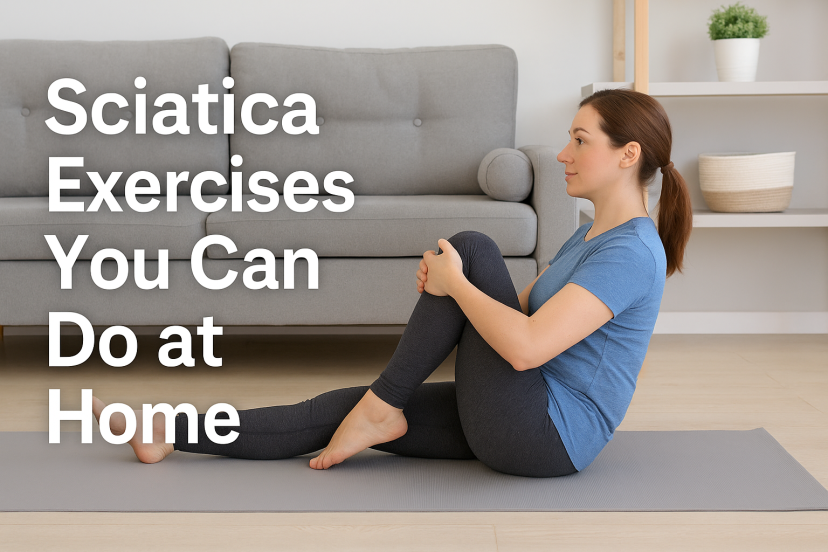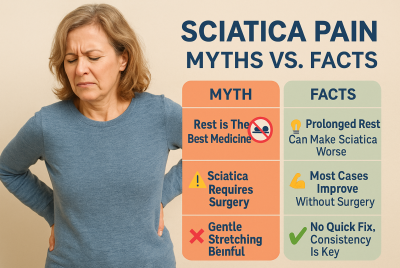Sciatica Exercises You Can Do at Home Gentle Stretches & Mobility Routines to Relieve Nerve Pain Naturally
⚡ Living with Sciatica Pain: Why Movement Matters
If you’ve ever felt a sharp, radiating pain from your lower back down to your leg, you know how relentless sciatica can be. It can make everyday tasks — like sitting, walking, or even sleeping — a challenge. Many people respond by resting more. But too much rest can actually make things worse.
That’s because motion heals. Gentle, consistent sciatica exercises you can do at home improve blood flow, reduce nerve pressure, and strengthen the muscles that protect your spine. And you don’t need fancy equipment or a gym — just a few minutes a day and the willingness to move.
🧠 Understanding Sciatica Before You Start
The sciatic nerve runs from your lower spine through your hips and down each leg. When this nerve becomes compressed or inflamed — from a herniated disc, muscle tension, or spinal stenosis — pain, tingling, and numbness can occur.
Exercise helps by:
-
Strengthening core and hip muscles that support your lower back
-
Improving flexibility to relieve nerve compression
-
Reducing inflammation through circulation
-
Preventing future flare-ups
🧘♀️ Warm-Up: Prepare Your Body for Movement
Before diving into specific sciatica exercises, start with a gentle warm-up to loosen tight muscles and prevent strain.
✅ 5-Minute Warm-Up Routine
-
March in place (1 minute) – increases blood flow
-
Shoulder rolls (10 forward, 10 backward) – reduces upper body tension
-
Pelvic tilts (10 reps) – warms up the lower back
-
Ankle circles (10 per side) – improves leg mobility
-
Deep breathing – relaxes your body and centers your focus
🌿 The Best Sciatica Exercises You Can Do at Home
These gentle stretches and mobility moves can help reduce inflammation, relieve nerve pressure, and restore comfort — all from the comfort of home.
1. 🧘♀️ Knee-to-Chest Stretch
Goal: Loosen tight lower back muscles and relieve pressure on the sciatic nerve.
How to do it:
-
Lie on your back with knees bent and feet flat on the floor.
-
Gently pull one knee toward your chest using both hands.
-
Hold for 20–30 seconds, then switch legs.
-
Repeat 2–3 times per side.
💡 Tip: Don’t force your leg too high — it should feel like a mild stretch, not pain.
2. 🍃 Piriformis Stretch (Seated or Lying)
Goal: Release tension in the piriformis muscle — a common cause of sciatica.
How to do it:
-
Sit on a chair with one ankle crossed over the opposite knee.
-
Keep your back straight and lean forward gently.
-
Hold for 20–30 seconds and switch sides.
Alternatively, lie on your back, cross one ankle over the opposite thigh, and pull your legs toward your chest.
3. 💪 Cat-Cow Stretch (for Spine Mobility)
Goal: Improve flexibility and reduce stiffness in the spine.
How to do it:
-
Start on hands and knees, wrists under shoulders, knees under hips.
-
Inhale and arch your back (cow pose).
-
Exhale and round your spine (cat pose).
-
Repeat 10–12 times slowly.
🌿 Tip: Focus on smooth, controlled breathing to calm tight muscles.
4. 🧍 Hamstring Stretch with Towel
Goal: Reduce tension in the back of the thighs and relieve nerve pressure.
How to do it:
-
Lie on your back and loop a towel or resistance band around one foot.
-
Keep the other leg bent on the floor.
-
Gently straighten the lifted leg until you feel a stretch.
-
Hold for 20 seconds and switch legs.
5. 🪑 Seated Spinal Twist
Goal: Improve spinal flexibility and release nerve tension.
How to do it:
-
Sit on a sturdy chair with both feet flat.
-
Place your right hand on the back of the chair and twist gently to the right.
-
Hold for 15–20 seconds, breathing slowly.
-
Return to the center and repeat on the left side.
🧘 Tip: Keep your back tall — avoid slouching.
6. 🦵 Pelvic Bridge
Goal: Strengthen the lower back, hips, and glutes to support spinal stability.
How to do it:
-
Lie on your back with knees bent and feet flat.
-
Tighten your core and lift your hips toward the ceiling.
-
Hold for 5 seconds, then lower slowly.
-
Repeat 10–15 times.
💪 Progression: Add a small pillow or yoga block between your knees to engage the inner thighs.
7. 🚶♀️ Gentle Walking or Treadmill Walking
Goal: Maintain circulation and reduce stiffness.
Even short walks (5–10 minutes) can help decompress the lower back and prevent nerve inflammation.
🦶 Tip: Wear supportive sneakers and avoid uneven terrain until pain improves.
🏡 Creating a Home-Friendly Sciatica Exercise Space
You don’t need a gym — just a safe, comfortable area with a few simple tools.
Recommended Items for U.S. readers:
-
Gaiam Extra Thick Yoga Mat (for cushioning knees and back)
-
ComfiLife Gel Seat Cushion (for sitting stretches)
-
TheraBand Resistance Loops (for mobility work)
-
Adjustable Standing Desk (to reduce sitting time)
🪴 Keep your exercise space calm and clutter-free to encourage consistency.
🌈 The Role of Physical Therapy and Mobility Work
If you’ve had recurring sciatica, combining home exercises with professional physical therapy can make recovery faster and safer.
A therapist can help:
-
Identify which movements are safest for your specific condition
-
Correct posture and alignment
-
Progress exercises gradually to build strength and flexibility
💬 In the U.S., physical therapy sessions often cost $40–$100 depending on insurance, but many therapists now offer at-home or telehealth programs.
💡 Additional Home Tips for Sciatica Relief
Pair your daily exercises with these habits for better results:
🛋️ Posture Support
-
Use lumbar cushions when sitting.
-
Avoid slumping on soft couches — sit with feet flat and knees at 90 degrees.
💤 Sleep Positioning
-
Sleep on your side with a pillow between your knees to keep the spine aligned.
-
Or on your back with a rolled towel under your knees for support.
🧴 Heat & Cold Therapy
-
Apply ice packs during flare-ups (10–15 min).
-
Use a heating pad afterward to relax tight muscles.
🥗 Anti-Inflammatory Diet
Combine exercise with foods rich in omega-3s, turmeric, and antioxidants (like salmon, berries, and leafy greens) to lower inflammation naturally.
⚠️ When to See a Doctor or Chiropractor
Most mild sciatica cases improve within a few weeks of consistent exercise.
However, seek medical attention if you experience:
-
Pain lasting longer than 8 weeks
-
Numbness or weakness in your legs
-
Loss of bladder or bowel control
-
Pain after a fall or injury
-
Suddenly, severe pain with fever or weight loss
A healthcare provider may suggest imaging (MRI or X-ray), chiropractic adjustments, or specialized physical therapy for targeted recovery.
❓ 7 Common FAQs About Sciatica Exercises You Can Do at Home
1. What are the best exercises for sciatica relief at home?
Gentle stretches like knee-to-chest, piriformis stretch, and cat-cow pose are highly effective for most people.
2. Can I do these exercises if my pain is severe?
If pain is sharp or worsening, rest first and consult your doctor. Start only when the pain is mild or moderate.
3. How often should I do these stretches?
Daily! Just 10–15 minutes per day can help relieve stiffness and support long-term healing.
4. What should I avoid when I have sciatica?
Avoid heavy lifting, deep squats, or twisting movements until your back feels stronger.
5. Can walking make sciatica worse?
Not if done gently — walking improves blood flow and can reduce nerve inflammation when combined with good posture.
6. How long does it take to feel better?
Most people notice improvement within 2–4 weeks of consistent stretching and posture correction.
7. Do I need equipment for these exercises?
No — a yoga mat or towel is enough. Resistance bands and cushions can help, but aren’t required.
🌿 Conclusion: Heal Through Consistent Movement
Sciatica recovery doesn’t require endless doctor visits or expensive equipment.
With these simple, gentle sciatica exercises you can do at home, you can strengthen your body, relieve nerve pressure, and regain your freedom of movement — one day at a time.
Stay patient, stay consistent, and remember: your body heals best when you keep it moving. 🧘♀️✨
💬 “Every small stretch today brings you closer to a pain-free tomorrow.”
⚕️ Medical Disclaimer
This content is for informational purposes only and is not a substitute for professional medical advice. Always consult your doctor or physical therapist before beginning any new exercise program, especially if you have chronic pain, injury, or other health conditions.

- How to Calm Sciatic Nerve Pain
- Why Is Sciatica So Painful?
- How Long Does Sciatica Last in Older Adults





